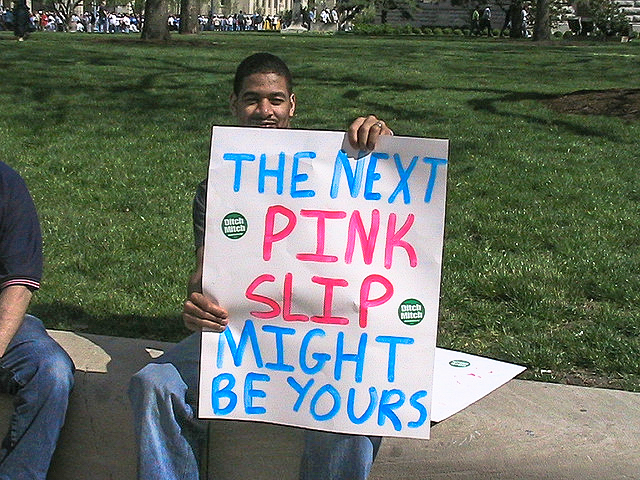Mike Elk, the labor reporter for Politico, is under fire. It’s not for any story in particular. It’s about who he is. Elk, a prominent labor journalist from a union family who was formerly with In These Times, is trying to organize the staff at the Beltway news organization.
Now, right-wing pundits are claiming that it is simply unethical for someone who sides with unions to cover the labor beat. An anti-union group, the Center for Worker Freedom, is offering its union-busting services to Politico, and in its rhetoric puts scare quotes around the word reporter when referencing Elk.
It’s true that Elk’s sympathies rest with unions. It shouldn’t be surprising. To suggest one must be neutral on the question of unionization in order to cover the labor beat is like saying a baseball fan can’t like the Red Sox even if she’s from Boston. Or that art coverage can only be conducted by those with no interest in the subject.
The suggestion also reveals a deep misunderstanding about what labor journalism is. To the outside observer, it might seem that there are unions, which are all pretty much the same, that want higher wages and employers who fight them, so clearly, being pro-union means you’re sworn to one side of the fight, and therefore can’t report with any clear vision.
But this really isn’t the case. As I taught in class at the Murphy Institute for Worker Education and Labor Studies at CUNY last year, labor journalism is much more dynamic. A labor reporter must cover schisms between unions. For example, how trade unions which fought for the XL pipeline because it would create jobs also fought against it for health and environmental reasons. Another example would be the choice of New York’s United Federation of Teachers to openly protest the police killing of Eric Garner, angering the city’s police union, showing how much cop unions can work against the social justice missions other unions have.
Being a labor journalist might also mean covering the often contentious relationship between public and private sector unions, with the prime example of a private sector union-backed party, the Working Families Party, endorsing Andrew Cuomo for governor in New York, even though his austerity policies have angered public sector unions, especially teachers unions.
Or, being a labor journalist might mean covering reform movements within unions, like the Teamsters for a Democratic Union, who fought to ensure individual voting rights were protected in the recent settlement to end federal oversight of the Teamsters. Or, show how there are vastly different agendas between seemingly similar unions, like the Chicago Teachers Union, which is currently run by a militant reform caucus, while the UFT in New York City has been governed by the conciliatory Unity caucus for four decades.

Being a labor journalist might also mean disproving the notion that there’s necessarily an adversarial relationship between unions and employers. Consider Fitch’s Law, named for union journalist and activist Robert Fitch, who posited that unions’ overall political interests were the same as those of their employers. Look to the UAW advocating for an auto industry bailout alongside the CEOs of the Big Three or the United Mine Workers of America campaigning against the Environmental Protection Agency because of what it would do to coal companies’ bottom lines as examples.
All of these things defuse the problem of being “pro-union” while on the beat, because a union really isn’t a singular interest, but really any individual union, either at the international or local level, should be probed like a nation, one with a head of state and congress (the executive board) and various factions competing against each other with different agendas and philosophies about how the union should move forward. And individual unions, like nations, have tensions and conflicts with each other, and have complex relationships with their supposed adversaries, in this case, employers.
These are important reminders, because the case of Mike Elk’s criticism from the right reveals an optimistic trend in labor journalism. While it was marked with sadness when long-time New York Times labor reporter Steven Greenhouse took a buy-out last year, new forms of labor journalism are on the ascendance, in part because the increased discussion on inequality since Occupy Wall Street. The 2008 financial crisis has similarly invigorated curiosity about employment and class in general, which invariable includes a discussion about unions.
All over the new media landscape, a demographic that counters the image of labor being the domain of the male, pale and stale is moving through the ranks of labor journalism. Sarah Jaffe and Michelle Chen, who also blogs about labor for The Nation, have a popular labor podcast. America’s lone labor reporter for a national newspaper, the Wall Street Journal‘s Melanie Trottman, is a black woman in stubbornly monochrome profession. It was refreshing to see in my class interest from people from different kinds of unions, with people of varying races, and especially women. The Internet makes it easier for rank-and-filers to start their own blogs critical of their own unions, an example of journalism being generally pro-union, but critical a specific form of union power.
The right’s attack on Elk stems from a provincial, simplistic understanding of what it means to care about unions, whether one is a journalist or not. The longer that goes on unquestioned, the more tempting it is for the left to internalize the false binary. That’s why more dynamic labor journalism in both left-wing corners, and in the mainstream, need to thrive, and indeed are thriving.
Photographs courtesy of Bernard Pollack and Mark Haller. Published under a Creative Commons license.





